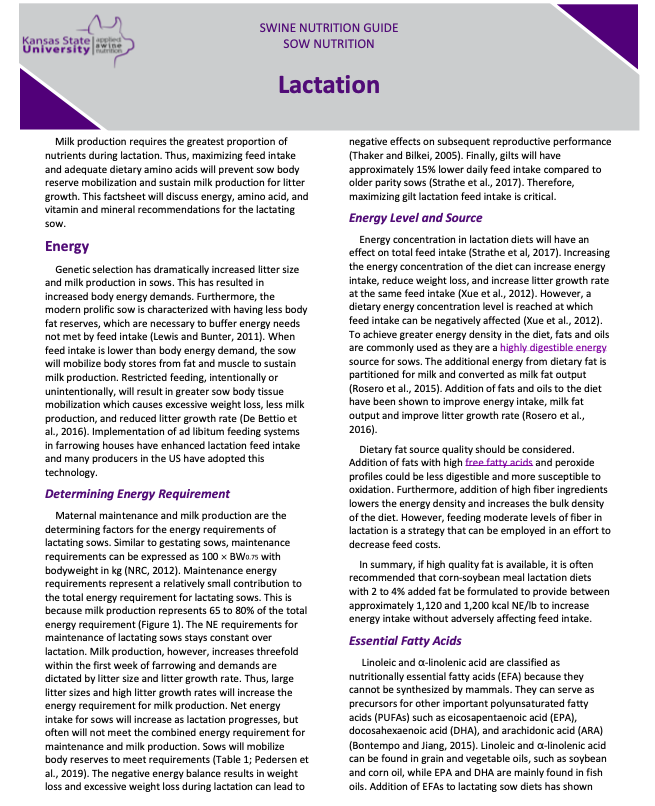Amino Acids
Milk protein synthesis constitutes approximately 70% of lactating sow amino acid requirements (Pedersen et al, 2019). Therefore, the number of pigs nursing in the litter and the litter growth rate will dictate the amino acid requirements of lactating sows (Table 2). It has been established that a balanced supply of amino acids close to the requirements is needed as this improves milk protein output and litter performance as well as reduces protein mobilization from tissues (Gourley et al., 2017; Strathe et al., 2017; Pederson et al., 2019).
Amino Acid Requirements
Lysine is the first limiting amino acid in most diets and lactating sows with larger and faster growing litters will require greater amounts of daily lysine to meet their needs. Previous research demonstrated that excessive weight loss and mobilization of body reserves during lactation impaired subsequent reproductive performance (Thaker and Bilkei, 2005). (Xue et al., 2012; Shi et al., 2015; Gourley et al., 2017). However, recent studies have shown inconclusive results on the influence of lysine intake on subsequent reproductive performance (Shi et al., 2015; Gourley et al., 2017). The equivocal results with reducing body reserve mobilization by increasing lysine intake could be due to the modern lactating sow having more protein reserves and being more resilient to the negative effects of body reserve mobilization from reduced feed intake (Patterson et al., 2011).
A sow lactation research summary using published data from 1972 to 1997 determined that approximately 11 g/ SID lysine intake per day was needed for each 1 lb increase in litter growth rate (Boyd et al., 2000). A more recent review has updated this regression analysis to include sows from 1998 to 2017 and determined that approximately 60 g/ SID lysine intake per day is needed to optimize litter growth rate for most sows (Figure 2; Tokach et al., 2019).
There is limited research directly measuring milk production or litter responses to other amino acids as compared to lysine (Fan et al., 2016; Greiner et al., 2017; Xu et al., 2017). After lysine levels are set, other amino acids relative to lysine can be calculated using the amino acid profile in milk and mammary tissue as well as the dynamic nature of body tissue mobilization during lactation (Kim et al., 2001). Amino acid recommendations for lactating sows are provided (Table 3).
Protein and Amino Acid Sources
The increased availability of feed-grade amino acids has allowed producers to reduce diet costs by including feed-grade amino acids to replace soybean meal in the diet while meeting amino acid requirements. Additionally, including more than 30% soybean meal in the diet can lead to reductions in feed intake (Gourley et al., 2019). Conversely, some research has observed decreases in litter growth rate based on parity and increases in preweaning mortality with increasing amounts of feed-grade amino acids in the diet (Touchette et al., 1998; Greiner et al., 2018). Current research indicates that lactation diets should be formulated with a minimum dietary digestible protein of 14% (approximately 16% crude protein; Strathe et al., 2017).
